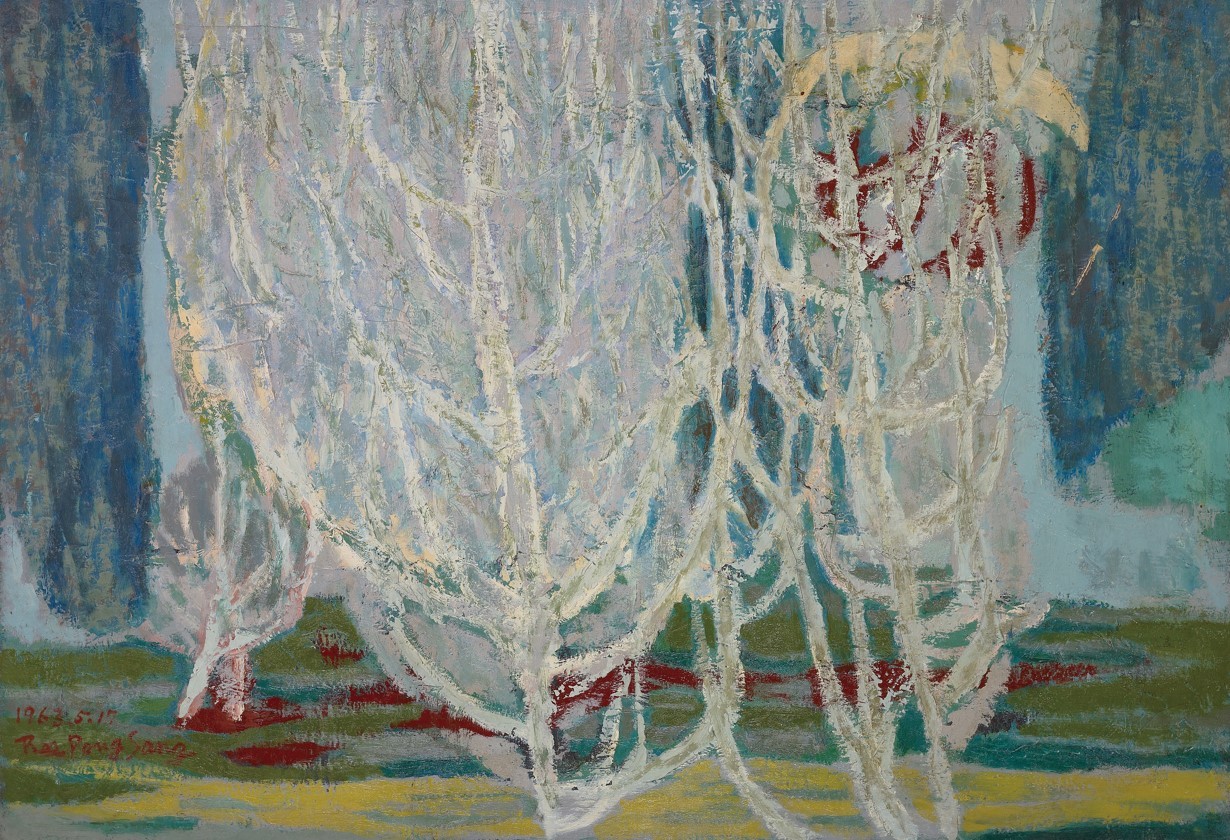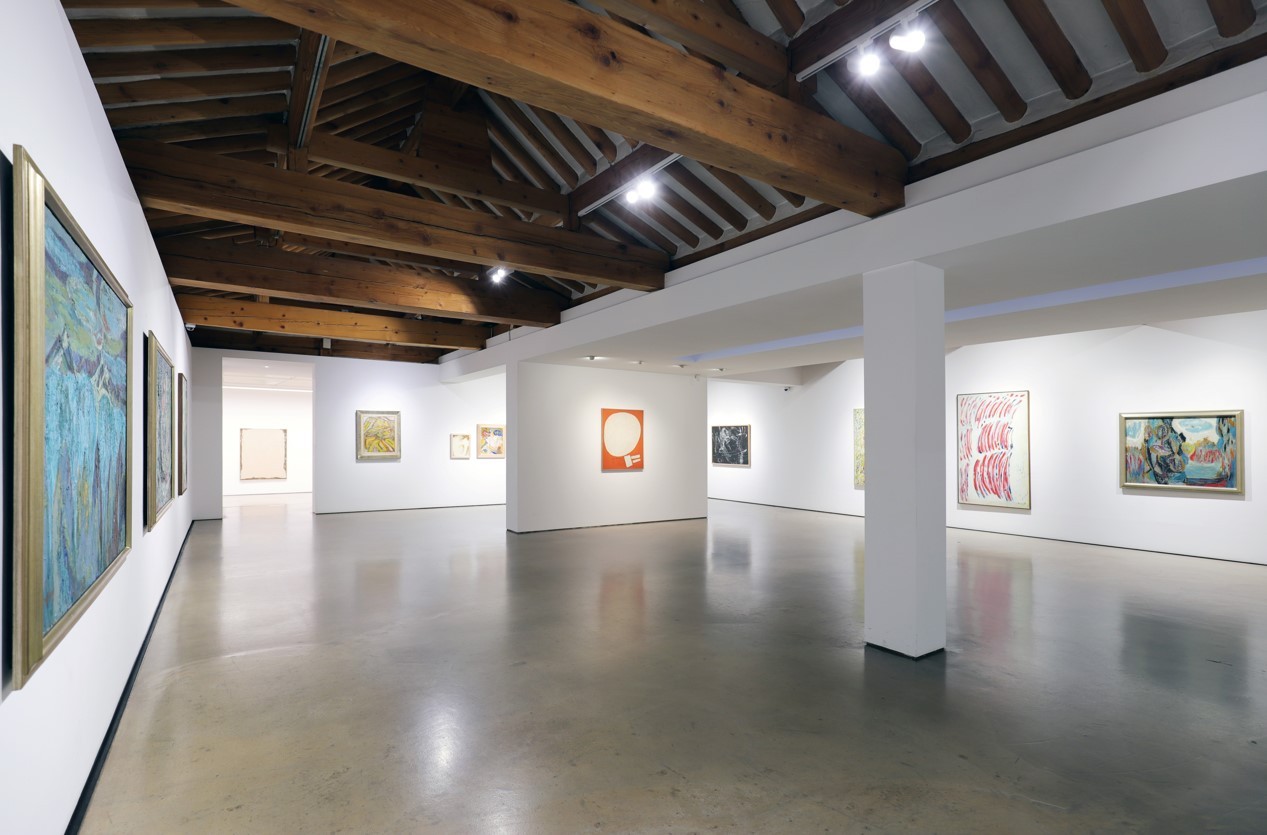Discover gems of Korean abstract art after Korean War at Hakgojae Gallery
Works by seven deceased artists reveal their agony in the mid-1900s
By Park YunaPublished : Feb. 3, 2022 - 08:24

Korea’s “dansaekhwa” abstract movement grabbed global attention in the early 2000s, but many more of Korea‘s abstract artists who developed their own styles and struggled to stand on their own feet have not received similar attention.
To help give them their due, one of Korea’s biggest art galleries is holding the exhibition “Seeking ‘Eidos’: Korean Abstract Painters 7,” to shed light on seven pioneers of Korea’s abstract art.
Hakgojae Gallery’s first exhibition of the year spotlights seven artists from the mid-20th century, with work that reveals the artists’ agony of the time, embracing Western influence on the one hand and escaping Japanese colonial impact on the other.
The gallery’s exhibition features works by Ree Bong-sang, Ryu Kyung-chai, Rhee Sang-wooc, Kang Yong-un, Ha In-doo, Ri Nam-kyu and Cheon Pyong-kun.
The artists -- born in the early 20th century -- have gone through the turmoil of the Korean War (1950-1953) and the rapid industrialization that followed as soon as the country gained independence from Japan.
To help give them their due, one of Korea’s biggest art galleries is holding the exhibition “Seeking ‘Eidos’: Korean Abstract Painters 7,” to shed light on seven pioneers of Korea’s abstract art.
Hakgojae Gallery’s first exhibition of the year spotlights seven artists from the mid-20th century, with work that reveals the artists’ agony of the time, embracing Western influence on the one hand and escaping Japanese colonial impact on the other.
The gallery’s exhibition features works by Ree Bong-sang, Ryu Kyung-chai, Rhee Sang-wooc, Kang Yong-un, Ha In-doo, Ri Nam-kyu and Cheon Pyong-kun.
The artists -- born in the early 20th century -- have gone through the turmoil of the Korean War (1950-1953) and the rapid industrialization that followed as soon as the country gained independence from Japan.

“After the Korean War, South Korea went through a compact and intensive industrialization. There is a gray area in dividing between modern art and contemporary art when it comes to works from these artists,” said Kim Bong-ki, president of Art In Culture and a professor at Kyonggi University. “It is almost a miracle that they flourished their artistic world after going through the Korean War and the military dictatorship.”
The seven artists, all of whom have now died, did not have opportunities to study abroad when their peers headed to Europe and the US to learn the abstract styles that had become fashionable in Korea, Kim added.
Work shown includes pieces by Ha In-doo (1930-1989) and Ri Nam-kyu (1931-1993) who were inspired by their religious beliefs as friends. Ha led the Art Informel movement in the country along with Kim Tschang-yeul and Park Seo-bo. In the mid-1970s, Ha sought to embody the spirit of Buddhism by deforming lines and using divergent symbols, especially mandala icons.
Ha incorporated the aesthetic spirituality of Buddhist painting and “dancheong,” a type of traditional Korean decorative painting used on wooden buildings and artifacts.
A Catholic, Ri established himself as Korea’s representative religious artist, stating, “The purpose of painting is the practice of asceticism of a true person in search of one’s real self. Painting is always like the journey of monks silently meditating at the Buddhist temple, and the goal is to train a philosophical artist, as evident in the painting.”
The exhibition runs through Sunday at Hakgojae Gallery in central Seoul. The gallery is closed on Mondays. As one of leading galleries in Seoul, it has showcased more than 200 exhibitions since its opening in 1988.
The seven artists, all of whom have now died, did not have opportunities to study abroad when their peers headed to Europe and the US to learn the abstract styles that had become fashionable in Korea, Kim added.
Work shown includes pieces by Ha In-doo (1930-1989) and Ri Nam-kyu (1931-1993) who were inspired by their religious beliefs as friends. Ha led the Art Informel movement in the country along with Kim Tschang-yeul and Park Seo-bo. In the mid-1970s, Ha sought to embody the spirit of Buddhism by deforming lines and using divergent symbols, especially mandala icons.
Ha incorporated the aesthetic spirituality of Buddhist painting and “dancheong,” a type of traditional Korean decorative painting used on wooden buildings and artifacts.
A Catholic, Ri established himself as Korea’s representative religious artist, stating, “The purpose of painting is the practice of asceticism of a true person in search of one’s real self. Painting is always like the journey of monks silently meditating at the Buddhist temple, and the goal is to train a philosophical artist, as evident in the painting.”
The exhibition runs through Sunday at Hakgojae Gallery in central Seoul. The gallery is closed on Mondays. As one of leading galleries in Seoul, it has showcased more than 200 exhibitions since its opening in 1988.








![[Kim Seong-kon] Democracy and the future of South Korea](http://res.heraldm.com/phpwas/restmb_idxmake.php?idx=644&simg=/content/image/2024/04/16/20240416050802_0.jpg&u=)








![[KH Explains] Hyundai's full hybrid edge to pay off amid slow transition to pure EVs](http://res.heraldm.com/phpwas/restmb_idxmake.php?idx=652&simg=/content/image/2024/04/18/20240418050645_0.jpg&u=20240418181020)

![[Today’s K-pop] Zico drops snippet of collaboration with Jennie](http://res.heraldm.com/phpwas/restmb_idxmake.php?idx=642&simg=/content/image/2024/04/18/20240418050702_0.jpg&u=)